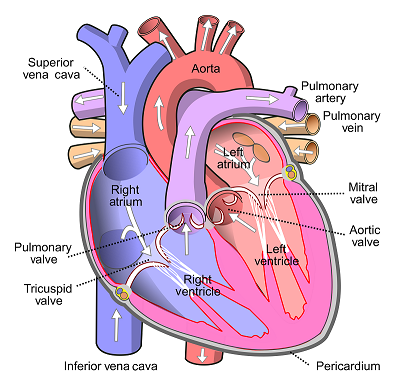What is Cardiovascular System of body?
The circulatory system also called cardiovascular system pumps blood from the heart and made to circulate around whole organs of body.
Heart is the main part of cardiovascular system. It is a fist sized muscular organ which is the main organ for pumping of blood in our blood circulatory system. Heart works as a pump to circulate blood in this system.
The circulatory system is a network of blood vessels called veins, arteries and capillaries responsible for distribution of oxygenated blood to all cells in body.
Heart also works with other body systems to control heart beat rate and blood pressure.
Structure of Heart
Human heart and cardiovascular system is consisting of following main 4 four chambers, valves and veins –
1.Right Auricle
Two large veins open in the upper right chamber called right auricle or atrium. It dealt with the impure (oxygen-poor) blood.
The superior vena-cava carries impure blood from upper part of body and deliver it to right auricle. The inferior vena-cava brings impure blood from the lower parts of body.
Then the right auricle pumps the blood to right ventricle.
2.Right Ventricle
The lower right chamber is called right ventricle. It pumps the impure blood to lungs through the pulmonary artery.
In the lungs, exchange of oxygen and carbon dioxide takes place and the impure blood is reloaded with oxygen and now called oxygen-rich or pure blood.
3.Left Auricle
After the lungs load the blood with oxygen, the pulmonary veins carry this blood to the left auricle or atrium. This upper chamber pumps the pure blood into the left ventricle.
4.Left Ventricle
The left ventricle is slightly larger than the right. It pumps pure blood to the rest of body.
5.Tricuspid valve
This three semi lunar valve makes door passage between right auricle and right ventricle.
6.Bicuspid valve
This two semi lunar valve makes door passage between left atrium and left ventricle.
7.Arteries
These carry pure blood from heart to all body tissues. The exception is pulmonary arteries which carry impure blood to lungs.
8.Veins
These carry impure blood collected from all parts of body back to heart.
9.Capillaries
These are small blood vessels where exchange of oxygen and carbon dioxide takes place.
Internal structure of human heart and various components is shown in figure.

Functions of Heart & Cardiovascular System
Human heart and cardiovascular system mainly performs the following important functions –
- It pumps and to move blood throughout the body.
- Controls the rhythm and speed of your heart beat.
- Maintain and regulates blood pressure.
- Works with other body systems to control their functions.
- With nervous system, it helps and control heart rate. Nervous system sends signals to beat slower during rest and faster during stress.
- With endocrine system through hormones, it controls blood pressure by sending signals to blood vessels to contract or relax for increase or decrease blood pressure respectively. Thyroid gland controls heart to beat faster or slower.
Heart Diseases
Heart disease is associated with several types of heart conditions. Sometimes, symptoms of heart disease may be silent and not diagnosed until a person experiences signs or symptoms of a heart attack, heart failure, or an arrhythmia. In United States, about 1 person in every 4 persons die from heart attack.
1.Heart Attack
Chest pain or discomfort, upper back or neck pain, indigestion, heartburn, nausea or vomiting, extreme fatigue, upper body discomfort, dizziness, and shortness of breath etc. are the common symptoms of heart attack.
2.Arrhythmia
Fluttering feelings in the chest (palpitations).
3.Heart Failure
Shortness of breath, fatigue, swelling of feet, ankles, legs, abdomen, or neck veins.
Risk factors of Heart diseases
Risk factors associated with heart diseases are –
- High blood pressure and high blood cholesterol.
- Habit of Smoking.
- Prolonged suffering from blood sugar and Diabetes.
- Body overweight & Obesity.
- Taking Unhealthy diet.
- Physical inactivity.
- Excessive alcohol consumption.
Healthy Heart
Following lifestyle changes is suggested to keep the heart healthy –
- Achieve and maintain a healthy body weight as per sex and age.
- Avoid to use alcoholic drinks and use of tobacco and smoking.
- Eat a healthy diet to keep your heart healthy with plenty of fruits, vegetables and whole grains.
- Exercise and work out for at least 30 minutes a day and 5 days per week.
- Limit sodium intake in food and salt.
Manage mental stress with healthy strategies like meditation, jogging etc.
